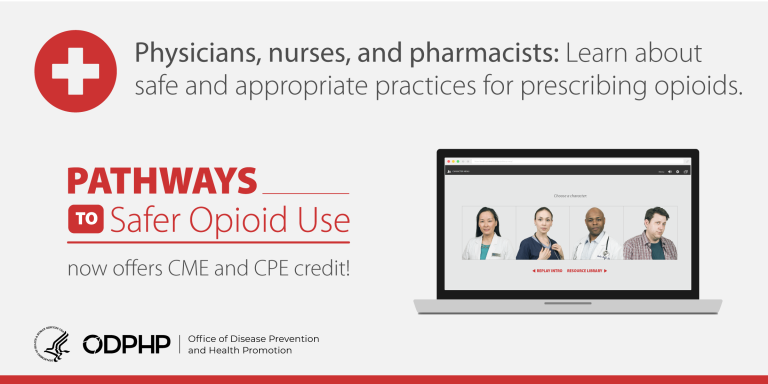Millions of adverse drug events (ADEs) happen every year, and opioids are one of the most common causes of medication-related harm in both inpatient and long-term care settings. In addition, data from 2013 to 2014 found that opioids — along with two other drug classes — were involved in an estimated 59.9 percent of emergency department (ED) visits for ADEs among older adults. The same data set found that ED visits for ADEs were a common cause of hospitalization.
That’s why opioids are one of the initial targets in the National Action Plan for Adverse Drug Event Prevention (ADE Action Plan), released by the Office of Disease Prevention and Health Promotion (ODPHP) in 2014. ODPHP also used recommendations from the ADE Action Plan to create the Pathways to Safer Opioid Use online interactive training.
The training is designed to help health professionals and students learn about safe use of opioids to manage chronic pain — and ultimately to reduce opioid-related ADEs in their communities. Users role play clinical scenarios as a pharmacist, a nurse, a primary care physician, and a patient. Live-action videos set the scene for users to choose different courses of action and watch them play out, learning core competencies of safe opioid prescribing practices in the process.
Evaluation as a Tool for Growth
Since 2015, ODPHP has partnered with the American Public Health Association (APHA) to promote the Pathways training and offer continuing education credit to users. This month, APHA will begin an evaluation of the efficacy of the Pathways training on behalf of ODPHP. Mighty Fine, Director of the Center for Public Health Practice and Professional Development at APHA, says the evaluation is a response to the growing number of health professionals using online resources for professional development. “We want to make sure that trainings like this are meeting the needs of our membership base and the healthcare workforce overall.”
Participation in the evaluation is voluntary, and consists of two surveys and a brief interview (users opt in to each part). Participants can expect to spend one hour completing the training, approximately 15 minutes on each survey, and approximately 30 minutes in the interview. Dr. Jamila Porter, President and Founder of The Stellaire Group and the lead evaluator of the Pathways training, stresses that evaluation is a critical step in developing a training product. “I’m glad ODPHP and APHA are taking the time to conduct such a robust evaluation. There’s a tendency to put something out there and say, ‘Check, we’ve done it.’ But going back and focusing on evaluation is so important.”
ODPHP also hopes to learn more about the audience for their eLearning trainings through the evaluation, and identify which key concepts and behaviors participants actually are implementing in daily practice. One such example, from Dr. Porter, is the teach-back method, where a clinician has the patient repeat back exactly how they intend to take their prescribed opioids. “We want to know if the provider is making sure that the patient fully understands the instructions.”
Anticipating Barriers, Building Supports
Dr. Porter explains that the qualitative findings will be especially helpful in identifying systemic barriers and supports. “We need to ask what changes would make behavior change more likely in their various practice circumstances.”
“There will always be barriers to behavior change,” she goes on. “But anticipating and discussing these obstacles can lead to meaningful improvements. The qualitative findings from this evaluation can serve as a springboard for conversations about how to address those barriers.”
Pathways to Broader Impact
ODPHP hopes to use APHA’s evaluation to improve the Pathways training — and highlight areas in which it is already effective. Mr. Fine is optimistic about the outcome. “We’re hoping to learn that this is an effective training that is well received by healthcare professionals. Ideally we would want to see that they apply what is learned to positively impact their prescribing practices and interaction with patients.”
Though small in scope, Dr. Porter sees larger potential in the evaluation. She stresses the urgency of the larger mission to combat opioid abuse and misuse. “People’s lives are being impacted adversely every day by opioid misuse. That gives us the impetus to collaborate and work quickly and effectively to make a difference.”




